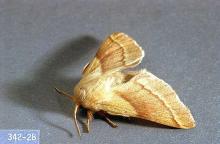Forest tent caterpillar (Malacosoma disstria)
Western tent caterpillar (Malacosoma californica)
Pest description and damage The western tent caterpillar attacks a wide variety of plants including alder, ash, birch, cottonwood, and willow as well as fruit trees and roses. The over 1-inch-long adult moths are attracted to lights at night. Mature western tent caterpillars can reach a length of about 2.0 inches and are hairy, dull yellow brown, with rows of blue and orange spots on the body. Mature forest tent caterpillars can be as long as 2.5 inches and are black and blue with dorsal white "footprints." Eggs of these moths are laid on twigs or buildings and may be especially numerous around lights at night. The egg masses are brown to gray, about 0.625 inch in length, and look like bits of gray, hardened foam. Larvae of both species construct unsightly nests or "tents" in the crotches and branches of host trees. Larvae leave the tent by day to feed on foliage of host plants and may do significant damage by defoliation. Larvae usually return to the tent in the evening. Tent caterpillars can defoliate small trees. Defoliation can hinder plant growth and make the plants more susceptible to competition, diseases, or poor weather and defoliation over consecutive years may weaken or kill unthrifty hosts. Healthy trees usually will grow new leaves by midsummer.
Biology and life history Tent caterpillars overwinter as egg masses on twigs or on buildings. Eggs hatch as buds break in April or May. Initially, caterpillars spin web-like tents about the tree crotches. These tents enlarge as the season progresses. Young larvae feed in groups for five to six weeks, growing larger and molting (shedding skins) four times. As they mature, they split into smaller groups and move to new feeding sites in the tree returning to the tent most evenings. In mid-June, mature larvae congregate in large clusters on dense mats of webbing on the tree trunk and then begin to migrate in search of sheltered sites where they can spin their cocoons and pupate. Adults emerge seven to 10 days later and fly in large numbers around lights at night. They mate and females lay the overwintering egg masses. There is one generation per year.
Pest monitoring Watch for egg hatch and the glint of the first white webbing of the tents early in the spring. A few tents do not threaten the health of the tree. The earlier the intervention, the more environmentally friendly options can be employed.
Management-cultural control
Trees that have been defoliated need additional, but not excessive, irrigation during dry summers to help them re-foliate. Healthy trees will withstand defoliation better than closely spaced, drought-stressed trees. Remove egg masses from twigs or other sites. Cut out infested twigs and discard.
Management-biological control
Heavy infestations of tent caterpillars occur from time to time as the populations of the caterpillars and their predators rise and fall. Tent caterpillars have many natural enemies. Some birds eat the caterpillars, and small mammals and birds will consume the pupa inside the cocoons. A tachinid fly parasitizes the caterpillars by laying a white egg on the caterpillar; the hatching fly larva then burrows into and feeds within the caterpillar. A Trichogramma wasp will also parasitize eggs. When pruning out tent caterpillar egg masses, discard the masses in a protected area away from a host plant so these parasitoids can emerge naturally.
Management-chemical control
See Table 2 in:
Chemical Control of Landscape Pests
For more information
See "Caterpillar" in:
Johnson, W.T. and H.H Lyon. 1991. Insects That Feed on Trees and Shrubs. 2nd ed.



